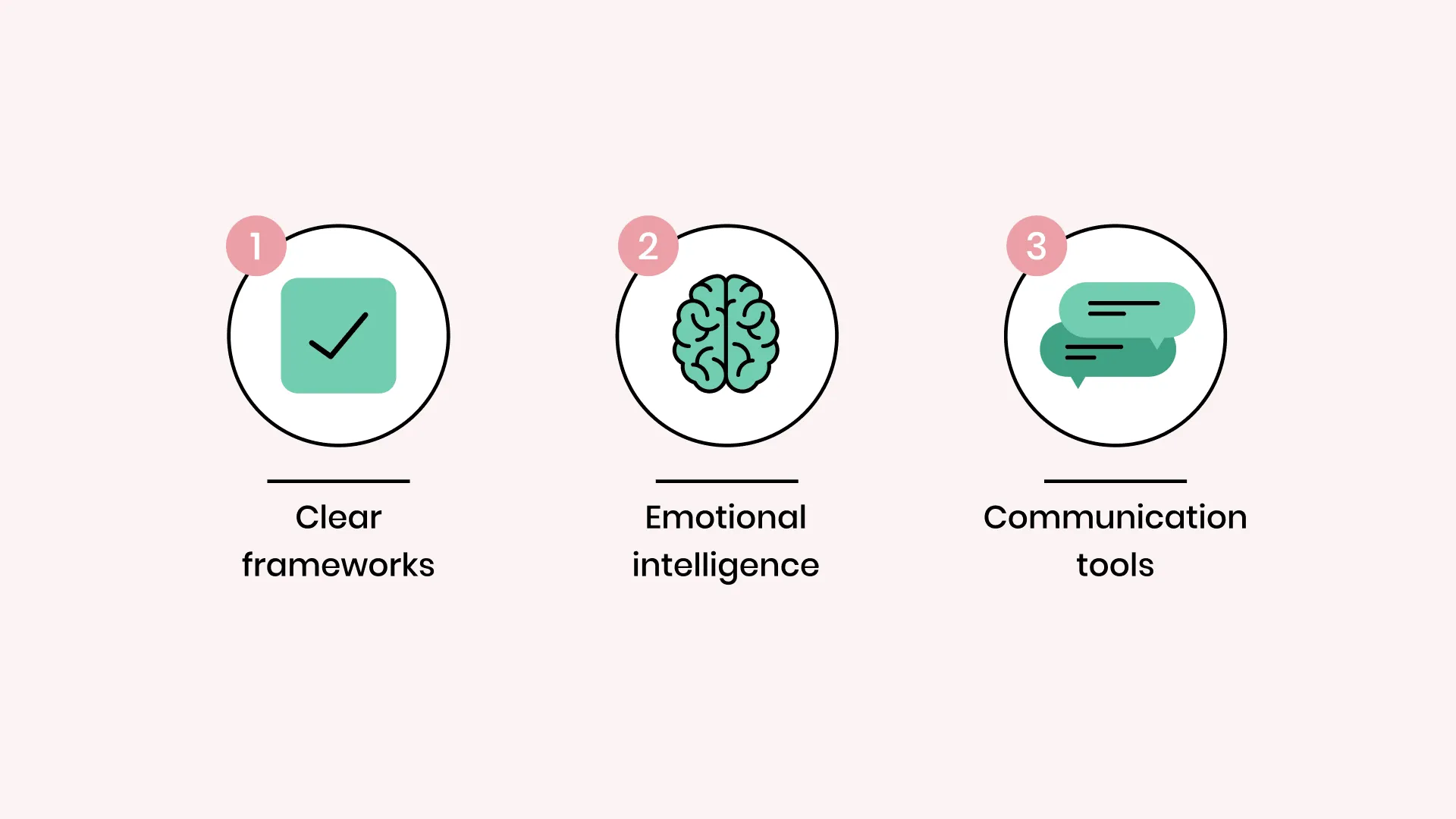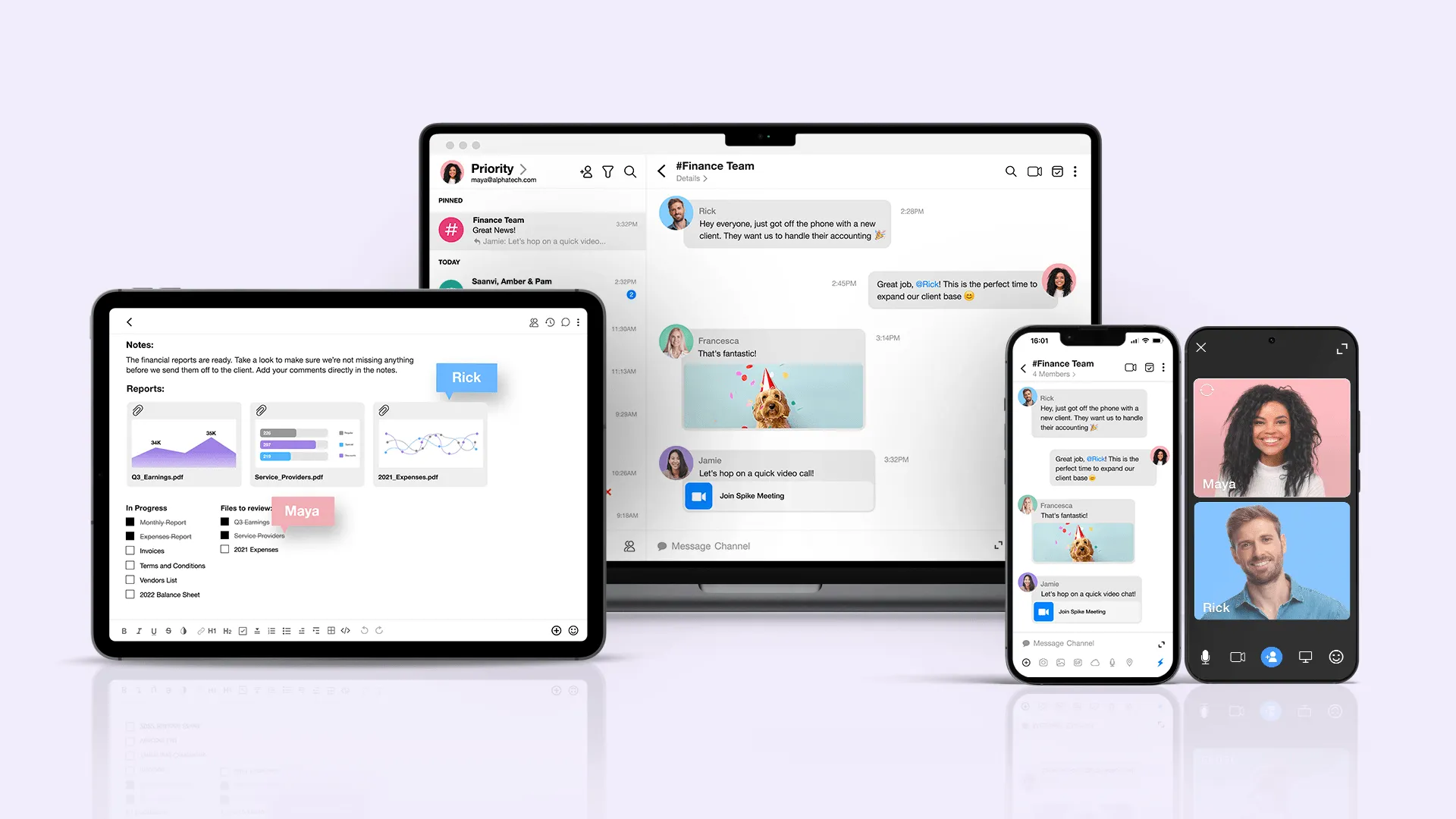Mastering Workplace Communication: Proven Strategies for Team Success

Imagine a team where communication flows effortlessly. Everyone knows their role, tasks are crystal clear, and collaboration thrives. Projects move smoothly from idea to execution, with no one left guessing. Now, picture the opposite: misaligned priorities, vague instructions, and missed deadlines that pile up like a game of broken telephone. The difference? Effective communication.
Effective workplace communication isn’t merely an ideal, a “nice to have” —it’s a fundamental necessity. Studies estimate that poor communication costs U.S. businesses around $1.2 trillion annually. And it’s not just the cost; only 26% of employees say they receive clear guidance from their managers.
This guide isn’t just a roadmap—it’s an invaluable resource packed with sharp insights into communication challenges. We’ll delve into the core issues holding teams back and provide innovative, effective methods to identify and repair bottlenecks.
Along the way, you’ll discover tools—like Spike—that aren’t just convenient but transformative, helping you build a team dynamic where communication is seamless, collaboration thrives, and productivity soars.
The 3 Core Principles of Workplace Communication
Three fundamental principles—clarity, consistency, and channels—are at the heart of excellent workplace communication. These simple yet powerful ideas are the backbone of any team’s ability to collaborate smoothly, spark innovation, and achieve meaningful results:
-
Clarity
Team members must know exactly what’s expected of them. This means clear instructions, well-defined roles, and unambiguous goals.
For instance, sending a concise email or brief outlining critical tasks and deadlines ensures no room for confusion. Clarity eliminates guesswork and increases alignment.
-
Consistency
Communication isn’t a one-time effort. A manager can’t relay his instructions once and expect the team to get on with it. Effective communication requires regular updates, i.e., daily standups, weekly check-ins, and monthly meetings.
The precise mechanics depend on the situation, and managers should apply their discretion. But fundamentally important is that their communication is consistent, fosters a rhythm, and cements trust.
-
Channels
Using a suitable medium for the message is as important as the message itself. Different tools serve different purposes.
For instance, a collaborative platform like Spike is ideal for ongoing team discussions and project management, while Slack works well for quick, informal updates. Matching the message to the medium ensures efficient and effective communication.
In short:
- Clarity ensures ideas don’t get lost in translation.
- Consistency keeps teams aligned.
- The proper channels ensure the right people get the correct information.
These principles aren’t just abstract—they’ll emerge again as we explore common challenges and actionable solutions. Communication bridges the gap between an informal work environment and the professionalism needed to align teams.
Strong communication brings clarity amidst complexity. It ensures everyone knows their role and expectations. At the same time, it fosters a space where voices are heard, feedback is valued, and creativity can flourish. Without it, even the best ideas risk withering in confusion, leaving potential untapped and progress stalled.
The power of clear delegation and feedback:
Imagine a team working on a high-stakes project.
When communication is clear –
- Every member knows their role, responsibilities, and deadlines.
- Delegation flows seamlessly, aligning efforts toward a shared goal.
- Tasks progress efficiently, with potential roadblocks identified and resolved early.
Now, picture the opposite –
- Unclear instructions create confusion and duplicate efforts.
- Deadlines are missed, and frustration builds.
- Accountability erodes, leaving the team misaligned and disheartened.
At the heart of this contrast is communication—the backbone of effective teamwork. The earlier principles of clarity and consistency are crucial here: clear delegation eliminates guesswork, and consistent feedback ensures no one is left in the dark.
Open feedback loops are equally critical. When employees feel safe sharing concerns, asking questions, or offering suggestions, misunderstandings are caught before they snowball into problems. Collaborative solutions emerge, strengthening both processes and relationships.
But feedback isn’t just a tool to avoid mistakes—it’s the foundation of trust. It creates a culture where employees feel valued, empowered, and confident that their voices matter. This dynamic doesn’t just prevent issues; it drives engagement, innovation, and long-term success.
3 Common Challenges Leaders Face in Communication
Today’s workplace presents unique communication challenges that didn’t exist a decade ago. Leaders must navigate evolving dynamics like increased informality, authority without control, and the delicate balance of assertiveness—all of which can disrupt collaboration if left unaddressed.
Let’s explore these modern hurdles and how to tackle them effectively.
1. The Rise of Informality in the Workplace
Modern workplaces pride themselves on being more inclusive, approachable, and casual. While these shifts foster innovation and reduce rigidity, they’ve also created unintended pitfalls. The blurring of professional boundaries can lead to:
- Misunderstandings: A manager’s overly casual tone in emails or meetings might be interpreted as a lack of authority, delaying progress, or creating confusion.
- Uneven dynamics: Team members may feel unsure about challenging informal directives, fearing they’ll appear disrespectful or overstepping boundaries.
This phenomenon, known as role ambiguity, occurs when employees lack clear signals about expectations and hierarchy.
A Linnaeus University study established that informal workplace dynamics pose a key challenge for the leader-junior relationship. Specifically, when formal structures are unclear or absent, junior employees often seek guidance and validation through informal channels.
This creates a paradox: while informality can foster approachability and support, it also blurs boundaries, leaving juniors uncertain about how to assert themselves without crossing perceived hierarchical lines.
Informality has its place, but unchecked, it can:
- Undermine authority, leaving leaders with less influence over their teams.
- Create uncertainty, where employees don’t know how to respond or act.
The solution lies in balance. Leaders must blend approachability with professionalism, ensuring clear and effective communication without sacrificing an inclusive culture.
2. Accountability without Authority
One of the most common frustrations for team leaders is being held accountable for results without the authority to enforce decisions or delegate effectively. This situation can feel like steering a ship without a rudder.
Consider a common scenario:
- A project lead needs input from senior colleagues but lacks formal leverage to set deadlines.
- Progress stalls, leaving the lead stuck in a frustrating loop of waiting and nudging.
This challenge, rooted in decision paralysis, highlights the importance of channels—using the right tools and frameworks to define decision-making pathways. Structured communication channels provide clarity and empower leaders to progress without needing constant external approval.
A Business Management Journal study found that without sufficient authority to match their responsibilities, employees often experience dissatisfaction, frustration, and low morale. These outcomes stem from being held accountable for tasks they cannot directly control.
The good news? This issue can be solved with:
- Structured communication channels: Clear pathways for sharing updates, setting expectations, and resolving roadblocks.
- Defined frameworks: Clearly outlined roles, responsibilities, and escalation paths to ensure accountability and progress.
- Promote collaboration: Create support systems where employees can escalate issues beyond their control.
- Feedback loops: Regular feedback sessions help address the constraints faced by accountable employees without authority.
We’ll explore these solutions later, showing how team leaders can effectively reclaim control and drive results.
3. The Assertiveness Dilemma
Navigating workplace dynamics can feel like walking a tightrope for junior employees. They need to:
- Be assertive enough to get their voices heard.
- Avoid being so forceful that they risk coming across as pushy or disrespectful.
Consider this scenario:
- A new hire notices a critical deadline is at risk but hesitates to raise the issue with a senior colleague.
- Their silence resulted in missed deliverables and strained relationships, all because they needed help to balance authority with assertiveness.
This balancing act, described by the power-distance paradox, underscores the value of consistency in leadership communication. When team leaders consistently encourage open feedback and foster psychological safety, employees are likelier to speak up without fear of overstepping boundaries. Consistency ensures expectations are clear and contributions feel valued.
Leaders can help their teams navigate this by:
- Encouraging constructive feedback: Create an environment where team members feel safe raising concerns and offering suggestions.
- Promoting proactive communication: Make it clear that speaking up—at any rank—is valued and encouraged.
When leaders foster this culture, they empower employees to contribute confidently and ensure potential issues are addressed before they become problems.
3 Actionable Strategies to Improve Workplace Communication

Strong workplace communication isn’t just about talking more—it’s about creating systems that ensure the correct information flows to the right people at the right time. Effective communication turns confusion into clarity, conflict into collaboration, and inefficiency into streamlined success.
The following three strategies are designed to address the most common challenges teams face, giving you practical and actionable ways to make communication your team’s superpower.
1. Design Communication Frameworks for Success
When roles and processes are unclear, confusion thrives. Clear frameworks eliminate guesswork by defining who handles what and how decisions are made.
- Create a communication charter: Outline team roles, responsibilities, and escalation paths for common scenarios.
- Use a decision-making matrix: Specify which tasks require manager approval and which can be handled autonomously. This empowers employees while ensuring critical decisions remain aligned.
Example:
A marketing team adopts a charter that specifies all content edits go through the team lead, while campaign strategies require director approval. The result? Fewer delays, more autonomy, and a smoother workflow.
2. Strengthen Team Dynamics with Emotional Intelligence
Emotional intelligence (EQ) is an often overlooked driver of workplace communication. It helps teams navigate misunderstandings, strengthen relationships, and collaborate effectively—even in high-pressure situations.
- Host workshops or courses: Focus on empathy, active listening, and non-verbal communication.
- Incorporate role-playing: Simulate difficult conversations to build confidence in real-world scenarios.
Example:
A company runs EQ training, where employees practice giving constructive feedback. The training not only strengthens relationships but also boosts team morale and productivity.
Developing emotional intelligence (EQ) within teams is crucial for effective communication and overall performance. Studies indicate that EQ accounts for 58% of success across various job types, with 90% of top performers exhibiting high EQ levels.
3. Leverage Tools to Bridge Gaps
The right tools can transform how teams communicate. With so many options available, selecting platforms that align with your team’s unique needs is essential to fostering seamless collaboration and reducing tool fatigue.
Here’s how popular tools stack up:
- Spike Email App combines email, chat, and team channels into a single platform for streamlined communication. It eliminates switching between multiple apps, offering clarity and focus.
- Slack is best for instant messaging and quick updates and facilitates informal communication. However, there needs to be a structure for email integration, which can lead to overwhelming notification fatigue in busy teams.
- Trello: A strong visual task management and project tracking contender, Trello is excellent for organizing workflows. However, it doesn’t offer direct communication features and often requires integration with other tools.
- Zoom: Perfect for face-to-face virtual meetings, Zoom is essential for synchronous communication but doesn’t adequately address asynchronous communication needs, leaving gaps in ongoing team collaboration.
Why Spike stands 0ut:
Spike’s approach uniquely addresses the shortcomings of other tools:
- Unified channels: Spike combines email and chat in one space, reducing tool fatigue and ensuring conversations stay connected to tasks.
- Formal and informal communication: Unlike Slack, which leans heavily into informal messaging, Spike supports both formal (email) and casual (chat) communication styles, giving teams the flexibility to adapt to different scenarios.
- Centralized collaboration: While Trello excels at task management, Spike’s integration of team channels and collaborative inboxes ensures tasks and communication coexist seamlessly.
- Asynchronous and synchronous flexibility: Spike bridges the gap between Zoom’s synchronous video calls and asynchronous email exchanges, ensuring no communication gets lost.
By addressing the limitations of other tools while combining their best features, Spike stands out as the ultimate platform for dynamic, communication-driven teams.
By adopting these strategies, team leaders can move beyond reactive communication and create a culture where clarity, empathy, and collaboration drive success. Whether through clear frameworks, emotional intelligence, or the right tools, these steps will help you build a more connected, high-performing team.
6 Game-Changing Communication Tips for Team Leaders
As a leader, your communication strategies set the tone for the entire team. Robust and intentional communication can transform workflows, foster creativity, and create a culture of trust.
Here’s how you can elevate your team’s communication with practical, proven methods:
1. Set the Tone for Transparent Communication
Transparency isn’t just a buzzword—it’s a cornerstone of effective leadership rooted in clarity and consistency. Leaders can create an environment where transparency thrives by setting clear expectations and consistently fostering an open feedback culture. Regularly emphasize that feedback is a two-way street where ideas, concerns, and solutions flow openly.
Actionable tip:
Begin team meetings by asking, “What’s one thing we could do better?” This simple prompt encourages openness and sets the stage for collaborative problem-solving.
2. Use Visuals to Clarify Complex Ideas
When things get complicated, visuals speak louder than words. They simplify workflows, clarify expectations, and provide a shared understanding for everyone involved.
Examples:
- Flowcharts to map out decision-making processes.
- Timelines to track project milestones and deadlines.
- Kanban boards for task management at a glance.
Actionable tip:
Use tools like Trello or Miro for collaborative, real-time visuals your entire team can access.
3. Conduct Weekly “Pulse Check” Meetings
Short, focused meetings can make a big difference. Regular “pulse checks” allow team members to address pressing issues without derailing their schedules.
What to cover:
- Roadblocks: What challenges are slowing progress?
- Wins: Celebrate achievements, no matter how small.
- Well-being: Gauge team morale and workload balance.
Actionable tip:
Keep these meetings under 15 minutes to maximize productivity and engagement.
4. Create a Culture of Written Follow-Ups
When discussions stay verbal, misunderstandings creep in. Written follow-ups ensure everyone leaves meetings aligned on goals and next steps.
Actionable tip:
After every meeting, assign a team member to send a recap email summarizing critical decisions, action items, and deadlines. This keeps projects on track and provides a reference point for future discussions.
5. Set Expectations for Response Times
Unclear response times can leave team members feeling frustrated or ignored. Setting clear expectations removes ambiguity and keeps communication moving. Establishing clear response time expectations is vital for maintaining productivity and trust.
Research shows that responding to leads within one minute can boost conversions by 391%, highlighting the importance of prompt communication.
Examples:
- Urgent requests: Respond within 2 hours.
- General inquiries: Reply within 24 hours.’
Actionable tip:
Use tools like Spike to consolidate communication channels and keep response times consistent across the team.
6. Rotate Roles During Team Meetings
Meetings shouldn’t always center on the same voices. Rotating roles fosters inclusivity and builds confidence in quieter team members.
Actionable tip:
Assign different team members to lead the agenda, facilitate discussions, or take notes each week. This enables fresh perspectives and ensures everyone feels engaged and valued.
By weaving these tips into your leadership routine, you’ll cultivate a team environment where communication thrives. These strategies aren’t just about improving workflows—they’re about building a culture where every voice matters and success is shared.
Conclusion

Effective communication isn’t just about exchanging words—it’s about creating a shared understanding, aligning goals, and empowering every team member to succeed.
Key principles:
By mastering fundamental principles like clarity, consistency, and using the proper channels, leaders can overcome challenges such as role ambiguity, decision paralysis, and the power-distance paradox.
These principles throughout this guide form the foundation for building high-performing teams.
Actionable strategies:
The actionable strategies we’ve covered—such as establishing communication frameworks, fostering emotional intelligence, and leveraging the right tools—offer a practical roadmap for transforming your team’s communication dynamics.
Creating clear charters to eliminate confusion, encouraging transparent feedback to build trust, or running pulse check meetings to keep everyone aligned will help you foster a culture of collaboration, innovation, and shared success.
Tools:
Among the many tools available, Spike stands out as a game-changer. Its unique combination of functionality, efficiency, and ease of use makes it an invaluable asset for team leaders.
Key features include:
- Channels: Organize team discussions by projects or topics for streamlined communication.
- Groups: Foster collaboration within focused, clearly defined private conversations.
- Email-Chat Hybrid: Combine email’s professionalism with instant messaging’s speed.
- Unified Platform: Eliminate the need for multiple tools, reducing clutter and boosting efficiency.
Ready to improve your team’s communication? Try Spike today and experience firsthand how it can revolutionize your team’s connection, collaboration, and goal achievement.




